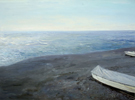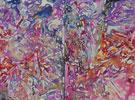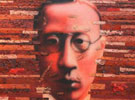In the Gujie Pozhang on the upper layer we cleared six rooms. In the highest altar room we found three round vaulted boxes lining the northern wall. Our research revealed that they once held sculptures of the “three white founders” among the five founders of the Sakya Sect. This practice of placing sculptures in open boxes on the wall was one of the marks of early buildings. A room next door was for housing Tibetan texts, where we found remnants of scriptures as well as wooden boards used for making bookcases and large amounts of richly inscribed gold plated bronze sheets for wrapping the altars of Buddha statues. According to records, the two buildings that served as altars for the protector spirits were among the earliest buildings at the Northern Temple. Built in 1073, the walls of the rooms still bore the traces of ancient frescoes, though they were of simple composition and crude painting techniques; large quantities of iron armor suits, helmets and arrowheads were also found nearby, but none of the remains or relics unearthed could serve as evidence of the building’s early construction date.
We found a ceremonial offering site on the east side of Gujie Pozhang. The remains were centered on a piled stone platform, with 10 offertory pits surrounding it. The pits contained pots that had been used in offerings. The pits usually had flagstones or pebbles on the bottom, with the walls reinforced by cobblestones. The pots were sealed around the edges with pebbles and covered with flagstone. Were these offertory pits for the founding of the temple, or are they the remains of a ritual to avert disaster? Even the oldest of the Lamas were unable to clear this up.
The Wumu Temple in the lower layer is made up of the Wumu Ningma Shrine and a Buddha temple to the north of it. Most of the original twelve pillars in the Buddha temple were preserved well, and the floor was made of solid aga mortar. Marks left by the original Buddha dais and the surrounding scripture racks were still visible. Though the southern half of the Wumu Ningma Shrine was damaged, the shape of the northern part was still very clear. Two rows of colvmn foundations were lined up east to west at a distance of 3.6 meters, and each foundation was 0.6 to 0.7 meters in diameter, showing that the original colvmns were massive. We discovered a two meter circular depression in the center of the shrine, which was probably the location for a large Mandala. Not many relics were unearthed during this excavation, only some goldplated bronze sheets for wrapping Buddha statue dais and some remnants of paper scriptures, but we were able to get a clear idea of the shrine’s overall layout, colvmn distribution and the shrine’s relationship to surrounding buildings, providing much reference information to assist in our understanding of the complex’s overall layout and former splendor.
During the 1980’s, the Sakya Temple organized its monks to excavate the Wumu Shrine. According to participants, they removed 4 large Buddha statues, 11 spirit pagodas and statues of protector spirits. They have been placed in the Southern Temple’s Puba Lakhang, Quera Lakhang, Spirit Pagoda Shrine and Lakhang Lazhang. The 1.2 meter tall Tara sculpture that now rests at the Quere Lakhang has a well- defined face, elongated body, supple breasts and curved waist, a perfect image of feminine youth. At the time they also unearthed a large amount of scripture remains, which are now housed in the Puba Lakhang in the Southern Temple. To better understand the situation of the scriptures of the Northern Temple, we invited Xiong Wenbin, a researcher from the China Tibetology Research Center to Sakya to comb over the scripture remains with us. He was able to identify 92 types of scriptures. Among them, complete pages had been organized by the monks, which were packed into four packages. We focused much of our energy on searching through these loose pages. There were cover pages and back cover pages, but most of the pages were from the middle of the original books. We were able to compile some pages according to the marked content, page numbers and script fonts, but most of the pages stood alone. The scripture pages ranged from 20 to 50 centimeters in length, with the largest stretching 71.5 centimeters in length and 28.5 centimeters in width. Most of the pages had 4 to 8 lines of text. The pages were made of handmade Tibetan paper, scroll paper and machine paper, with most of them falling in the first category, either blve or natural in color. Blve paper is usually used for written script, while the natural color paper is used widely for both handwritten and woodcut script. There were 43 types of written works identified. Among them, one especially worth noting is marked in the Chinese script as Page Twenty Six of the Saddharmapundarika Sutra. Above the name of the sutra is an illvstration of 6 monks from the Chinese interior holding a religious ceremony; the text below is in the Tibetan script. We also discovered diagrams of Yoga and religious implements, sutras marked with chanting guides, and pages from books and letters.
On the south and west sides of the Deque Pozhang site stand many pagodas, creating a rather large pagoda forest. Over the ages, many of the pagodas have already fallen, and the remaining ones have been heavily damaged by people. Records show that some of the pagodas were erected quite early, and played an important role in the formation of the Sakya Northern Temple. We made a detailed examination of these pagodas in 2006, creating a layout diagram. Following the order of the examination, we separated the pagodas in the south and west into areas I and II, respectively. There were a total of 49 pagodas in Area I and 66 pagodas in Area II. Using the data from the examination, we excavated the closest row of pagodas on the south side. There were 9 pagodas in this row. Aside from the large pagoda on the east side that was independently erected, the other eight pagodas were erected close together on a single elongated foundation. These pagodas represented the eight great events of Sakyamuni’s life, and are known as the “eight auspicious pagodas” (the lotus pagoda for birth, Bodhi pagoda for enlightenment, turning the dharma wheel pagoda for beginning the ministry, overcoming the spirits pagoda, returning from paradise pagoda, unity pagoda for uniting the factions, longevity pagoda and nirvana pagoda). The steeples of the eight auspicious pagodas had been destroyed long ago, and the bodies were severely damaged. The terracotta of the underground sections had been scattered around the area, but what was left of the bodies and bases allowed us to see the different structures.
By mid autumn, the two year excavation project of the Sakya Monastery had been completed. Two years of hard work, two years of rewarded effort gave us a better understanding of ancient Sakya.
Excerpt from “CHINA’S TIBET” 2. 2007




